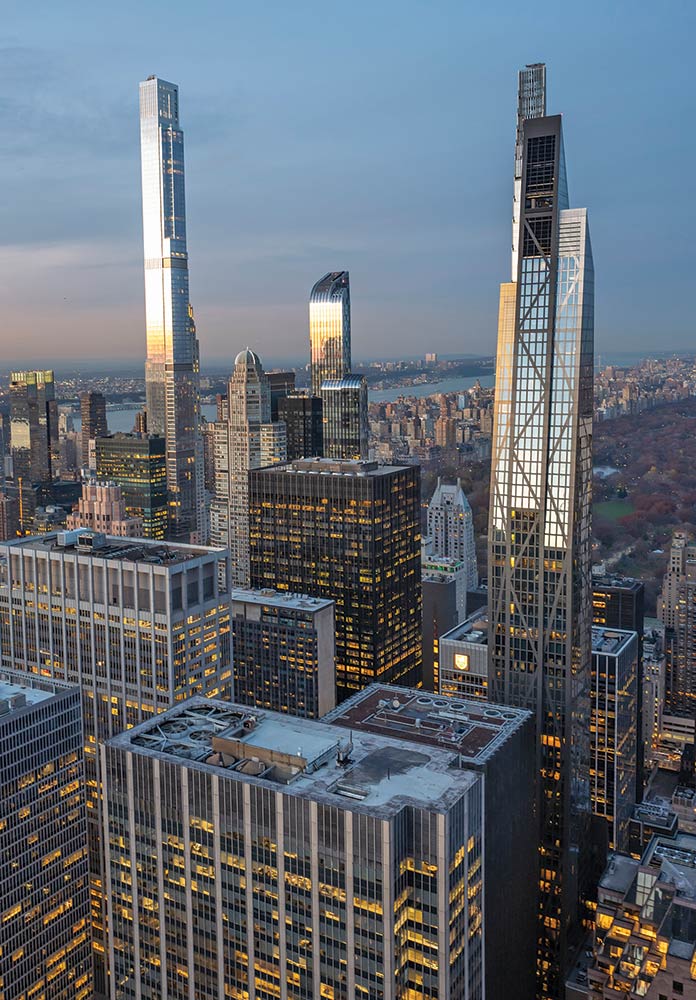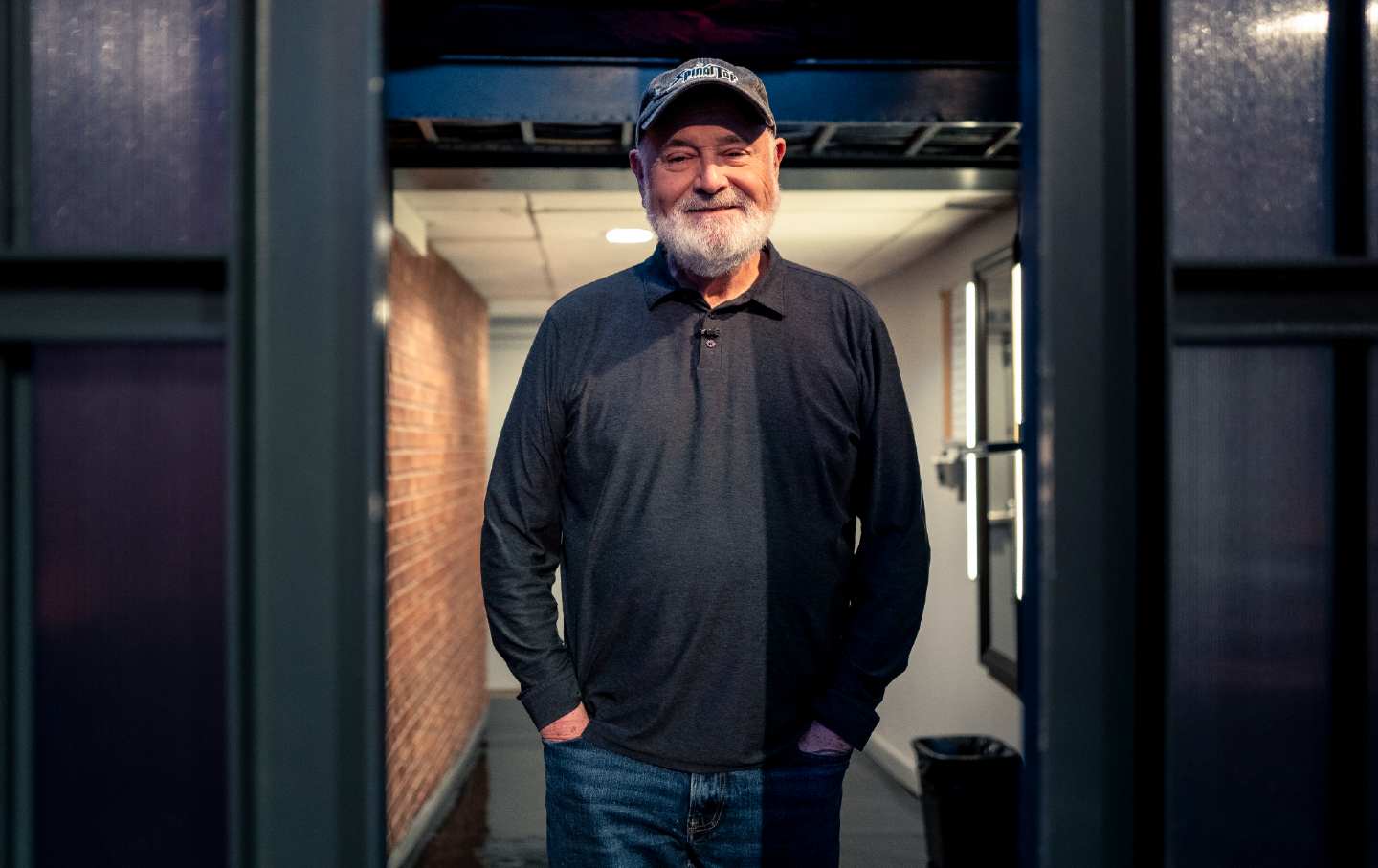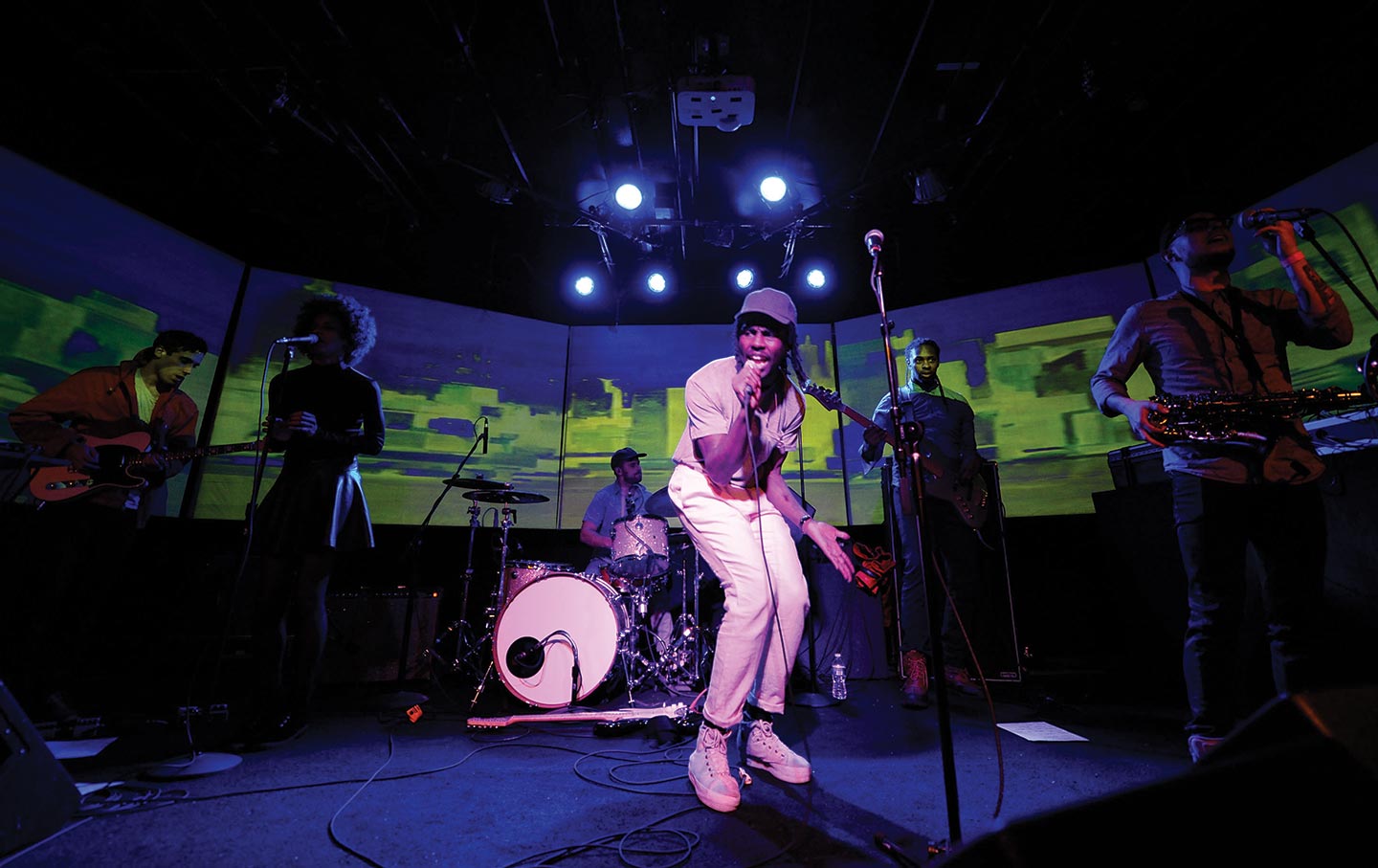Elevators and Escalades
The rise of New York’s super-tall luxury buildings.
What’s the Deal With Manhattan’s Pencil-Thin High Rises?
A walk along 57th Street.

In Billionaires’ Row, a book by the Wall Street Journal reporter Katherine Clarke, we are presented with a riveting narrative in which the heroes of her account, the developers Harry Macklowe and Gary Barnett, race to build the city’s first very tall and exceptionally skinny condo towers. And when I say “very tall and exceptionally skinny,” I mean it: Macklowe’s project, at 432 Park Avenue, was planned to be a soaring 1,397 feet in height, while Barnett’s project (known as One57), at 157 West 57th Street, was just over 1,000 feet tall. And because these buildings are so much taller than they are wide, some unorthodox engineering was needed just to keep them standing upright: 432 Park, for example, has five double-height floors open to the elements to allow the wind to pass right through.
To those who follow New York City’s real-estate high jinks, Macklowe and Barnett were already well-known. Back in 1985, Macklowe achieved tabloid infamy by bulldozing a string of Times Square single-room-occupancy hotels to make room for a 38-story luxury hotel, just days ahead of a city moratorium on the demolition of this much-derided (but inarguably necessary) form of low-cost housing. Barnett, the chairman of a company called Extell, is no slouch either: He achieved his notoriety during Superstorm Sandy, when a damaged crane dangled from the roof of One57 and took a solid week to be properly secured.
Yet, as Clarke documents, the greatest challenge the two men faced in their race to finish the city’s first super-tall condo tower was money: It was very complicated to assemble the financing and, not incidentally, to buy the air rights from surrounding properties, which, under New York City’s zoning rules, would allow them to build taller than the floor-area ratio (or FAR) would otherwise permit.
One problem for both developers was that they were cobbling together financing in the wake of the 2008 mortgage meltdown, which meant that banks were not eager to lend—especially for speculative projects like outrageously slender towers for the superrich. Macklowe, at a certain point, tried to partner with an entity called CMZ Ventures. The “M” stood for Paul Manafort, Donald Trump’s future campaign manager, who brought in a potential backer for the project, Dmytro Firtash, a Ukrainian oligarch with alleged connections to the Russian mob. Firtash said he would provide $112 million in equity to help Macklowe, but the funds never arrived. A 2011 civil suit alleged that Firtash and his cronies were using supposed real-estate deals to cover up a money-laundering scheme; while the suit was ultimately thrown out, the gambit found its way into special counsel Robert Mueller’s investigation. Eventually, Macklowe’s financing would come from a Los Angeles–based private-equity fund called CIM. Barnett’s search for a backer, meanwhile, led him abroad, to an investment fund based in Abu Dhabi.
Clarke’s chronicle of these high-profile developers doing backflips to attract investors reminds me of a similar story I once wrote—except mine wasn’t about funding luxury condos but about the labyrinthine process of funding affordable housing. The obstacle in this case wasn’t the refusal of banks to lend, but rather that we no longer build new public housing in the United States, so low-cost homes can be built only via a labor-intensive process of securing tax breaks and vouchers. As the noted for-profit affordable-housing developer Jonathan F.P. Rose told me, a typical project requires six to 12 funding sources. An affordable-housing developer in New York often gets funding in the form of the low-income housing tax credits created under an arcane system in which major corporations can reduce their tax bills by funding low-cost housing.
All I could think while reading about the genesis of Billionaires’ Row in midtown Manhattan is that, in a sane world, corporations (and billionaire condo owners) would simply pay taxes and the government would directly fund low-cost housing. And guys like Macklowe and Barnett might even be killing themselves to build housing for people who want a decent place to live rather than a safe place to park their money.
Ours, however, is not a sane world. So the competition between these two developers to build the city’s first super-tall luxury apartment tower didn’t do anything to alleviate the shortage of housing for actual New Yorkers. Instead, it spawned more such towers and kicked off an aggressive reinvention of West 57th Street, a crosstown thoroughfare that has never been exactly one thing or another. In the past, it was known primarily for a motley assortment of high culture (Carnegie Hall, art galleries, the Art Students League), low culture (remember Planet Hollywood?), and eateries that—with the possible exception of the Russian Tea Room—were not generally regarded as destinations.
Many people I know, or that I encounter on social media, are outraged by how the towers of Billionaires’ Row distort the city’s skyline. The buildings are so tall that they’re hard to miss, but so skinny that they look more like a row of smokestacks. They possess a dystopian weirdness that suggests to me they were designed more by software than by human architects—and that the software might have made a miscalculation or two.
Admittedly, I have a genuine affection for the late Rafael Viñoly’s 432 Park: It’s the one skinny tower that, from the outside at least, has some aesthetic coherence. (Its inner workings, as reported by Stefanos Chen of The New York Times, are another matter altogether: The building has been plagued by flooding, elevator problems, and weird noises. Also, the ultrarich, it seems, don’t like each other any more than they like the rest of us: “Everybody hates each other here,” one condo owner told Chen.)
But what offends me about these towers is not the skyline they’ve created, but how they behave at street level. Specifically, I’ve thought a lot about what happens to a midtown Manhattan street when it’s remade for people who don’t live or work there and who come and go intermittently via the massive black Suburbans and Escalades that are perpetually idling near the front doors.
A couple of years ago, I took my School of Visual Arts grad students for a walk that began at Columbus Circle, then followed 57th Street to Park Avenue and headed south to Grand Central. Along the way, we looked carefully at each of the new condo towers, paying attention to how they were designed and how they functioned at street level. Then, on Park Avenue, we looked at the mid-century modernist icons built as corporate headquarters—Lever House, the Seagram Building, Pepsi-Cola—that were at one time as controversial as the super-talls that line Billionaires’ Row.
The thing we realized as we walked around is that West 57th is something of a ghost town. Of course, there are people on the street, because it’s still Manhattan. But those who shelled out tens of millions for their apartments (the top asking price was $250 million for the Central Park Tower penthouse, later reduced) are not exactly promenading types.
Then, as we strolled down Park Avenue, stopping to discuss each significant building, it became apparent that the corporations that built them had deployed their wealth in a way that was more inclusive. Or, at least, those buildings came with generous plazas that were available to anyone who wanted to linger. The emaciated towers of 57th Street, on the other hand, are only for those who have bought into them. The emphasis of the marketing websites for these buildings is, of course, on the gloriousness of the interiors: luxe finishes, stupendous views, and amenities like “the highest private ballroom on the planet.” But the main selling point—the asset that developers, according to Clarke, have sued each other over—is the view of Central Park. This public place, the amenity that none of these developers with all their machinations can offer exclusively, is precisely what they’re selling. What the oligarchs are spending tens of millions to purchase is something that, in truth, belongs to you and me. So it seems reasonable to wonder about the impact that these very private towers will have on the public realm that makes them so valuable.
There are some good things that have come from the construction of the super-talls. For example, the Central Park Tower has New York’s first Nordstrom’s at its base. And it’s a nice enough department store. But mostly, the real-estate deals that were necessary to build these towers erased many of the businesses and shops that were the lifeblood of the street. The landmark Steinway Hall, formerly home to a famed piano showroom, is now the entryway to 111 West 57th and houses a health club for the billionaires upstairs. Signs in the window advertise unleased retail space.
On the next block east, there are four tremendous vacant lots, an unusual circumstance in midtown. One of them, on the north side of the street, is slated to become a 1,100-foot-tall condo tower—renderings show an elongated wishbone—with a hotel on the lower floors, developed by Sedesco and designed by the Dutch architecture firm OMA. Another vacant lot, next door to the Solow Building, a 1970s office tower with a sloping façade, is jointly owned by the developers LeFrak and Vornado. About a decade ago, they demolished three older buildings, including the beloved 109-year-old home of Rizzoli Books. At the time, it was assumed that the site was being cleared for another addition to Billionaires’ Row. But sales on the extravagant condos have slowed considerably; one recent report said that 23 percent of the sponsor units in the towers remain unsold, and if you count the owners trying to resell their apartments, that means something like 50 percent of the units are currently on the market.
Popular
“swipe left below to view more authors”Swipe →As it turns out, 432 Park—my favorite on the skyline—is the one that works best at street level. Yes, the building is a fortress, with a forbidding garage entrance and black SUVs parked on the marble slabs out front. As Clarke notes in her book, the “builders installed sliding wooden pocket doors separating the front desk area, which was visible to outsiders, from the elevator banks,” allowing residents to wait for an elevator hidden from the prying eyes of the public. But 432 Park, like Seagram or the Lever House, at least has a privately owned public space (or POPS, as they’re known), which is usually the result of a deal made between the developers and the city that allows for things like more building height in exchange for a parklet. It’s an attractive one, too, with Bertoia chairs and little round tables, and paved with the same slabs of marble that surround the tower’s entrance.
However, even this unusually generous (by Billionaires’ Row standards) handout to the plebs betrays a degree of antipathy. The plaza out front comes with the longest list of restrictions I’ve ever encountered in a nominally public place. The sign begins with a warning: “Disregard of the rules may subject you to removal.” The forbidden activities include almost anything you could possibly do other than sit very, very quietly: tree climbing, relocating furniture, distribution or posting of any literature, sound amplification, bird feeding… “All packages,” the sign notes, “are subject to screening or removal at owner’s expense.” The list is so draconian that it is unintentionally revealing, exposing the chasm between those who see this city as something that belongs to all of us, and those who have never learned to share.
Disobey authoritarians, support The Nation
Over the past year you’ve read Nation writers like Elie Mystal, Kaveh Akbar, John Nichols, Joan Walsh, Bryce Covert, Dave Zirin, Jeet Heer, Michael T. Klare, Katha Pollitt, Amy Littlefield, Gregg Gonsalves, and Sasha Abramsky take on the Trump family’s corruption, set the record straight about Robert F. Kennedy Jr.’s catastrophic Make America Healthy Again movement, survey the fallout and human cost of the DOGE wrecking ball, anticipate the Supreme Court’s dangerous antidemocratic rulings, and amplify successful tactics of resistance on the streets and in Congress.
We publish these stories because when members of our communities are being abducted, household debt is climbing, and AI data centers are causing water and electricity shortages, we have a duty as journalists to do all we can to inform the public.
In 2026, our aim is to do more than ever before—but we need your support to make that happen.
Through December 31, a generous donor will match all donations up to $75,000. That means that your contribution will be doubled, dollar for dollar. If we hit the full match, we’ll be starting 2026 with $150,000 to invest in the stories that impact real people’s lives—the kinds of stories that billionaire-owned, corporate-backed outlets aren’t covering.
With your support, our team will publish major stories that the president and his allies won’t want you to read. We’ll cover the emerging military-tech industrial complex and matters of war, peace, and surveillance, as well as the affordability crisis, hunger, housing, healthcare, the environment, attacks on reproductive rights, and much more. At the same time, we’ll imagine alternatives to Trumpian rule and uplift efforts to create a better world, here and now.
While your gift has twice the impact, I’m asking you to support The Nation with a donation today. You’ll empower the journalists, editors, and fact-checkers best equipped to hold this authoritarian administration to account.
I hope you won’t miss this moment—donate to The Nation today.
Onward,
Katrina vanden Heuvel
Editor and publisher, The Nation
More from The Nation

Rob Reiner’s Legacy Can't Be Sullied by Trump’s Shameful Attacks Rob Reiner’s Legacy Can't Be Sullied by Trump’s Shameful Attacks
The late actor and director leaves behind a roster of classic films—and a much safer and juster California.
Solution to the “Big Event” Crossword Solution to the “Big Event” Crossword
If questions remain after reading this, please write to sandy @ thenation.com.

Blood Orange’s Sonic Experiments Blood Orange’s Sonic Experiments
Dev Hynes moves between grief and joy in Essex Honey, his most personal album yet.

Ars Poetica with Backup from The Clark Sisters Ars Poetica with Backup from The Clark Sisters
after “Is My Living in Vain?”, 1980



